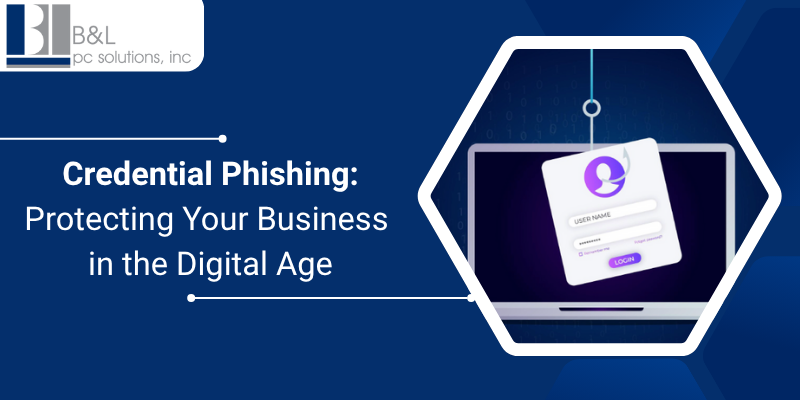
If your business faces a serious threat from an invisible and silent enemy, it’s from credential phishing. It is emerging as one of the most dangerous forms of cyber threats that businesses dread.
At B&L PC Solutions, we want every organization to be aware of the facts about phishing and understand how phishing works. It's the first measure you could take to guard your business from digital crime.
Let's explore credential phishing, its significance, how attackers work, how to identify fraudulent efforts, and real measures your staff can follow.
What Is Credential Phishing?
Credential phishing is a form of social engineering. Cybercriminals cunningly pose as your trusted sources to steal various sensitive credentials, such as usernames, passwords, and sensitive access details.
Their approach is to impersonate banks, cloud services, workers, owners, or even your own IT divisions. They convince you that you are being contacted by an authorized person. By manipulating you to click on fake links, wrong attachments, or malicious email content, they access the login data.
Companies caught in credential phishing suffer major effects. A data breach, financial loss, and a loss of reputation can all result from a single incorrectly entered password.
Such credentials enable cybercriminals to profit on the dark web or to carry out more assaults.
How Does It Work?
The main component of phishing assaults is fraud. A typical situation is as follows:
You receive an email that looks as authentic as ever, from IT support. It has a link to reset your password. The message features the company logo and uses the usual tone and language, giving you no reason to doubt its origin.
The link provided leads to a version of your login page that’s nearly identical, except for a few things unlikely to catch your attention unless you are extra careful. You enter your credentials. You have opened the door to your critical data to the attackers. Your account gets hacked in no time.
Attackers use different ways to refine this deception:
- They create similar domains with slight misspellings.
- They submit fake forms that request a username, password, and other details, including security questions.
- Mobile phishing is done through SMSs, WhatsApp messages, and voice calls (vishing) can be used to request credentials.
- Direct messages on LinkedIn or Facebook may appear to be urgent requests from known contacts.
On Whom Cybercriminals Concentrate?
Businesses are the key targets, but they can come after anyone with financial resources.
- The main targets are the top executives, finance teams, and human resource departments.
- IT administrators are used to accessing system credentials.
- Regular staff members often become the entry points for broader attacks.
Startups and emerging businesses are also targeted, as it is assumed they spend less on cybersecurity and related training.
Signs of Credential Phishing
Vigilance is absolutely necessary. You must be able to identify the most important indicators.
- Phishing communications usually aim to generate instant pressure (Your account will be locked unless you reply within 10 minutes!).
- Sender Address Looks Unusual: Look for odd domains, extra characters, or slight misspellings. Carefully examine the addresses of senders.
- Hover over links before clicking suspicious ones. Check if the link leads to the genuine portal.
- Requests that Appear Abnormal: Companies, banks, and tech support will never ask for your password by email or SMS.
- Spelling Errors: Poor layout and clear spelling mistakes abound in many phishing emails.
- Unusual Attachments: Files from unexpected sources, especially if they’re requesting ‘urgent’ responses.
What Happens If Credentials Are Stolen?
- Account Takeover: Attackers log into your systems and access confidential data.
- Wire Fraud: Payment details are changed to ensure funds are transferred to criminal accounts.
- Business Email Compromise: Phishing generally leads to more targeted attacks.
- Further Breaches: Stolen passwords are reused against other accounts, as many people reuse passwords.
Often, you don’t discover the breach until major damage has been done.
How to Protect Your Business
Cybersecurity must be every individual’s responsibility, not just that of IT professionals. Here’s how your business can fight back:
Employee Awareness
Teach your staff to recognize phishing attacks, report dubious messages, and anything that seems unusual. Giving simulated phishing attacks and ongoing security training can truly help you change things.
Employ Multi-Factor Authentication (MFA)
Even if your credentials are lost, MFA will guard your business. That’s because attackers will require a second authentication factor, such as a phone code or biometric scan. MFA thus helps reduce risks significantly.
Employ Strong, Unique Passwords
Do not encourage the common practice of password reuse. Password managers can help reduce accidental risks by autofilling details only on authentic sites.
Keep Systems Updated
Use security patches. Do not delay updating devices and applications.
Conduct Simulations
Run simulated phishing attacks to check how your staff will respond to phishing situations. It will improve their ability to spot unusual events.
Use Security Technology
Advanced email filtering, web protection services, and threat intelligence tools are available. They can help identify and block many malicious emails and fake sites.
Report Incidents Quickly
Take quick action if you accidentally enter your credentials on a bogus website. Change the passwords for all affected sites. Inform your IT group about the event. Watch out for suspicious conduct closely.
Changing Nature of Threat
Cybercriminals are finding credential phishing very attractive. They employ more complex techniques to trap their targets. Attackers nowadays employ new channels, including QR codes and collaboration tools, in addition to mass campaign automation and artificial intelligence. Organizations must be highly vigilant and employ advanced protection measures.
Conclusion
Credential phishing is spreading rapidly across industries and affecting businesses of all sizes. You must keep a watch on how these scams are evolving., By recognizing the signs and deploying a layered defence, B&L PC Solutions helps clients and educates them.
Contact B&L PC Solutions for cutting-edge security systems, employee training, and cybersecurity measures tailored to your company’s needs.
Tags: CredentialPhishing, CyberSecurity





